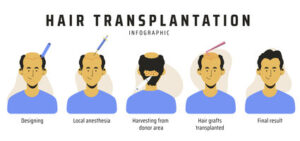To what to expect: 15 days after hair transplant
![]() Dr Baykal Oymak on March 9, 2023
•
0 Comments
• Tags: #15daysafterthehairtransplant #hairtransplantaftercare
Dr Baykal Oymak on March 9, 2023
•
0 Comments
• Tags: #15daysafterthehairtransplant #hairtransplantaftercare

A hair transplant is a life-changing procedure for those seeking to regain a fuller head of hair. However, the journey to a head of hair that looks and feels natural is not immediate. Understanding what to expect in the days following your hair transplant is essential for a successful recovery and the best possible results. 15 days after hair transplant, you’ll be well on your way to a transformed appearance, but patience and proper care are crucial.
1 to 15 Days After Hair Transplant: The Early Stages

Swelling and Redness
In the first few days after your hair transplant, it’s common to experience some swelling and redness in the transplanted area and the donor site. This is a natural part of the healing process and should start to subside within a week or so. You can use prescribed medications to help reduce these symptoms and make your recovery more comfortable.
Scabbing and Crusting
Within a week after hair transplant, the transplanted area will develop scabs and crusts as part of the natural healing process. It’s essential not to pick at or scratch these scabs, as doing so could dislodge the newly transplanted hair follicles and affect your final results. Instead, follow your surgeon’s guidelines for cleaning and moisturizing the area.
Shedding
Around two weeks post-transplant, you may notice some shedding of the transplanted hairs. This can be disconcerting, but it’s entirely normal. Your newly transplanted hair follicles will go into a resting phase before they begin to grow new hair. This phase is temporary and should be followed by healthy hair growth within a few months.
During this 15-day period
Days 1-7
The transplanted area may appear as it did immediately after the surgery, with some swelling and redness. Scabbing and crusts may start to form on the recipient site, and you’ll want to continue following the post-operative care instructions provided by your surgeon to promote proper healing.
Days 8-15
The redness and swelling should gradually decrease, and the scabs may start to fall off, revealing the newly transplanted hair follicles. You might experience some hair shedding during this time, which is entirely normal.
Mild Discomfort
Mild discomfort or pain during the initial days after a hair transplant is expected. Your hair transplant surgeon will prescribe pain medications to help manage this, and it should gradually improve. Most patients are comfortable within a week, but everyone’s experience varies.
Avoid Strenuous Activities
During the first 15 days after hair transplant, it’s crucial to avoid strenuous physical activities that can increase blood flow and raise blood pressure, as this may affect the grafts’ survival. Follow your surgeon’s advice on when it’s safe to resume regular exercise.
Scarring and Donor Site Healing
The donor site, typically located at the back or sides of your head, may have stitches or small incisions. These will heal over time, but it’s essential to follow post-operative care instructions diligently to minimise scarring and ensure the best possible outcome.
Baricitinib: A New Medication for Alopecia
In recent years, researchers have been exploring new treatments for hair loss conditions like alopecia areata, and one such promising medication is Baricitinib. This oral medication, initially approved for the treatment of rheumatoid arthritis, has shown potential in the management of alopecia areata. Baricitinib works by suppressing the immune system’s response, which is often overactive in patients with alopecia areata, causing hair loss.
While Baricitinib is not a replacement for a hair transplant, it represents a significant advancement in the field of hair restoration. It can be used in conjunction with other treatments to promote hair regrowth in individuals suffering from autoimmune-related hair loss conditions.
Clinic Follow-ups for Hair Transplant After 15 Days
Post-operative follow-ups with your hair transplant clinic are crucial for monitoring your progress and addressing any concerns. Here’s what to expect during these visits:
First Follow-up (around 7-10 days post-op)
15-Day Follow-up (around the 15th day)
This visit is important, as it falls within the period discussed in this article. The surgeon will evaluate your progress and address any specific issues you’re experiencing, such as persistent swelling or discomfort.
Ongoing Follow-ups
Your surgeon will schedule additional follow-up appointments at various intervals in the months following the surgery to monitor your hair’s progress and provide recommendations for ongoing care. These appointments are essential to ensure the long-term success of your hair transplant.
Conclusion
A hair transplant is a transformative procedure that requires patience and proper care in the days following the surgery. 15 days after hair transplant, you can expect some initial signs of the change, but the complete results will take time to manifest. Stay committed to following your surgeon’s instructions and maintain a healthy lifestyle to ensure the best possible outcome from your hair transplant. Additionally, keep an eye on emerging treatments like Baricitinib, which may offer new hope for those dealing with alopecia. Regular follow-up appointments with your hair transplant clinic will help ensure your recovery is progressing as expected and any potential issues are addressed promptly.
Your journey to restored hair and confidence begins here.

Dr. Baykal Oymak is a highly esteemed transplant specialist hailing from Turkey, boasting an impressive 17-year tenure in the medical field. His professional journey commenced as a dermatologist at Bogazici Hospital in Istanbul, where he began to hone his expertise. Since then, Dr. Oymak has conducted a remarkable tally of approximately 14,000 triumphant hair transplant procedures within Turkey. Additionally, he holds specialization in PRP treatment and Mesotherapy, further solidifying his reputation as a versatile and accomplished practitioner in the realm of dermatology and transplantation. » SCHEDULE YOUR HAIR TRANSPLANT IN TURKEY HERE «
